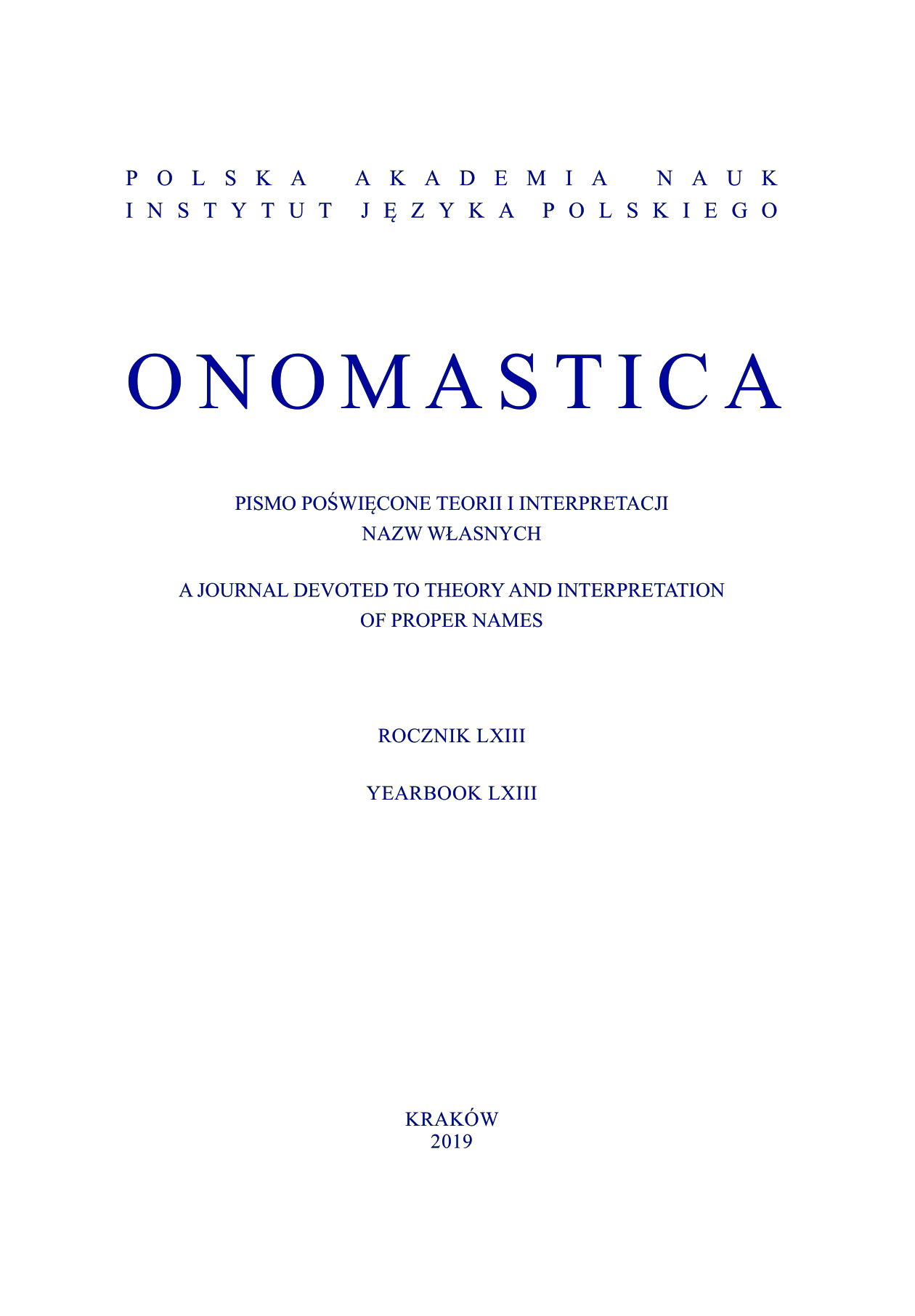Streszczenie
The Translation of Chinese Proper Names: A Cognitive Approach
The article focuses on the translation of non-literary Chinese proper names, a subject which to date has not enjoyed much research interest as a result of the common belief that proper names are untranslatable. The article discusses techniques used in the translation of Chinese anthroponyms, toponyms and brand names into Polish and English. The author refers to the strategies used in the process of transferring names to the target language and presents the consequences of applying given techniques from the cognitive perspective, which entails analysing the names in terms of their structure and meaning. Particular attention is paid to the connotations of the names, the impact they have on the speakers of a given language, as well as the mental images that can be derived from their structure. In the contrastive analysis of the names of tourist locations in Beijing and their Polish and English equivalents, the author applies the cognitive grammar approach as developed by Ronald W. Langacker. The image schemas of the names are used to present the distinct conceptualizations embodied in the names with the same references in different languages. One of the chapters describes how European names are adapted into Chinese. The study also provides an overview of the characteristics of the Chinese onomasticon, a factor which makes translation from Chinese to European languages particularly complicated. The observations made in the course of the analysis permit conclusions to be drawn on the linguistic worldview created by Polish, Chinese and English propria.
Bibliografia
Bogdanowicz, E. (2017). Konotacje nazw własnych (na materiale publicystyki prasowej) [Connotations of Proper Names (Based on Press Publications)]. Białystok: Wydawnictwo Uniwersytetu w Białymstoku.
Hejwowski, K. (2004). Kognitywno-komunikacyjna teoria przekładu [The Cognitive-Communicative Theory of Translation]. Warszawa: PWN.
Hessler, P. (2007). Walking the Wall. Can one man’s obsession solve the mystery of an ancient structure? The New Yorker [online]. Pobrano z: http://www.newyorker.com/magazine/2007/05/21/walking-the-wall (dostęp: 6 IV 2017).
Kaleta, Z. (2005). Teoria nazw własnych [The Theory of Proper Names]. W: E. Rzetelska-Feleszko (red.). Polskie nazwy własne. Encyklopedia [Polish Proper Names. Encyclopaedia] (s. 15–36). Warszawa–Kraków: TNW — IJP PAN.
Kałużyńska, I. (2001). Współczesne chińskie nazwy miejscowe (nazwy miast i powiatów) — cechy strukturalne i semantyczne [Contemporary Chinese Place Names (Names of Cities and Districts) — Structural and Semantic Traits]. Onomastica, XLVI, s. 125–146.
Kałużyńska, I. (2007). Nowe zjawiska w dziedzinie chińskich nazw osobowych [New Phenomena in the Domain of Chinese Personal Names]. W: A. Cieślikowa, B. Czopek-Kopciuch, K. Skowronek (red.). Nowe nazwy własne — nowe tendencje badawcze [New Proper Names — New Research Trends] (s. 125–146). Kraków: PANDIT.
Künstler, M. (2006). O pewnych cechach specyficznych onomastyki dalekowschodniej [On Certain Specific Characteristics of Far Eastern Onomastics]. Onomastica, LI, s. 65–72.
Langacker, R.W. (2009). Gramatyka kognitywna. Wprowadzenie [Cognitive Grammar: A Basic Introduction]. Kraków: Universitas.
Lewicki, R. (2010). Niektóre kulturowe aspekty ustalania ekwiwalencji w przekładzie nazw własnych [Some Cultural Aspects of Selecting Equivalents in the Translation of Proper Names]. W: R. Lewicki (red.). Przekład — Język — Kultura II [Translation — Language — Culture II] (s. 31–38). Lublin: Wydawnictwo UMCS.
Lubaś, W. (1973). Onomastyka w systemie językowym (na przykładach słowiańskich) [The Onomastics in the Linguistic System (on Slavonic Examples)]. W: I. Bajerowa, W. Lubaś (red.). Prace Językoznawcze II (s. 7–25). Katowice: Uniwersytet Śląski.
Mandola, M. (2015). Egzonimizacja polskich toponimów w języku francuskim [Exonymisation of Toponyms of the Territory of Poland in French Language]. W: A. Gałkowski, R. Gliwa (red.). Mikrotoponimy i makrotoponimy w komunikacji i literaturze [Microtoponyms and Macrotoponyms in Communication and Literature] (s. 81–95). Łódź: Wydawnictwo UŁ.
Nowakowska-Kempna, I. (1979). Transpozycje nazw własnych z języka polskiego na języki południowo-słowiańskie [Transposition of Proper Names from Polish to the South Slavic Languages]. Katowice: Uniwersytet Śląski.
Pieńkos, J. (2003). Podstawy przekładoznawstwa. Od teorii do praktyki [The Basics of Translation: from Theory to Practice]. Kraków: Zakamycze.
Poluszyński, B. (2012). Strategie tłumaczeniowe stosowane podczas przekładu nazw własnych na przykładzie wybranych polsko-angielskich artykułów z Wikipedii (analiza jakościowa i ilościowa) [Translation Strategies Used in the Translation of Proper Names Based on the Polish-English Articles from Wikipedia (Qualitative and Quantitative Analysis)]. Języki Obce w Szkole, 4, s. 42–50.
Siniarski, J., Zajdler, E. (2011). Kulturowy aspekt kodowania informacji w języku i piśmie — nazwy handlowe wiodących marek zagranicznych we współczesnym języku chińskim [The Cultural Aspect of Coding Information in Language and Writing: Names of the Leading Foreign Brands in the Contemporary Chinese]. W: E. Zajdler (red.). Zrozumieć Chińczyków: kulturowe kody społeczności chińskich [Understanding Chinese People: the Cultural Codes of Chinese Communities] (s. 131–174). Warszawa: Wydawnictwo Akademickie Dialog.
Tabakowska, E. (1990). Językoznawstwo kognitywne a poetyka przekładu [Cognitive Linguistics and Poetics of Translation]. Teksty Drugie, 3, s. 97–114.
Tesone, J.E. (2011). In the Traces of our Name. The Influence of Given Names in Life. London: Karnac Books.
Wolnicz-Pawłowska, E. (2014). Nazwy własne w przekładzie. Zarys problematyki [Proper Names in Translation. An Outline of Key Topics]. W: M. Graf (red.). Przestrzenie językoznawstwa. Prace dedykowane Profesor Irenie Sarnowskiej-Giefing [Spaces of the Linguistics: Studies Dedicated to Professor Irena Sarnowska-Giefing]. Poznańskie Spotkania Językoznawcze, 27, s. 201–214.
Woźniak, M. (2009–2010). Przegląd bibliograficzny polskich i wydanych w Polsce prac i artykułów o przekładzie literatury dziecięcej [A Bibliographic Overview of the Polish Articles on Children’s Literature Translation]. Przekładaniec. A Journal of Literary Translation Studies, 22–23, s. 283–292.
You, X. (2010). Writing in the Devil’s Tongue: A History of English Composition in China. Carbondale: Southern Illinois University Press.


